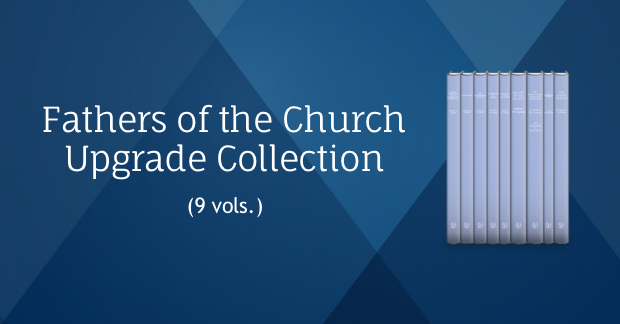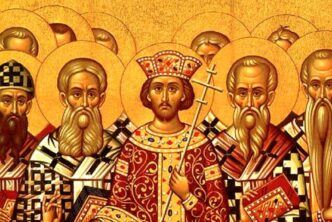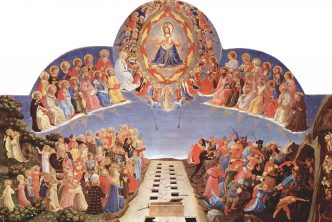 The doctrines handed down throughout history didn’t just magically appear. Our faith is the result of centuries of close Bible reading, of debates and councils, and of rich tradition in the Church. From the Trinity to the New Testament church, we discover the origins of key doctrines by reading the Church Fathers’ writing.
The doctrines handed down throughout history didn’t just magically appear. Our faith is the result of centuries of close Bible reading, of debates and councils, and of rich tradition in the Church. From the Trinity to the New Testament church, we discover the origins of key doctrines by reading the Church Fathers’ writing.
In this excerpt adapted from On Ecclesiastical Theology by Eusebius of Caesarea, we see how the Church came to understand Jesus’ relationship to the Father—begotten, not made; distinct, but not different.
***
For this reason, then, the Church of God, rightly discerning1 the straight and imperial way, rejected the other ways that diverge [from this one], and hands over to its children [this] knowledge of inspired grace, teaching them to confess in the very mystery of rebirth,2namely, to believe in one God the Father who rules over all, giving them to know that in this way the theology is perfect and exact and complete in all its parts, which hands down:
- One God in contradistinction to the polytheistic error of the Greeks,
- But knows that he is Father in opposition to the teaching of the Jews,
- And confesses that he is ruler over all, turning away from the impiety of the godless heterodox.
In any case, none of the heterodox would say that the Father of Christ is the same as the God who rules over all,3nor would any of the Jews confess that God is a Father since they do not know the only-begotten Son, nor would a Greek say that he recognized one God alone.
For this reason, then, purifying itself of the error of all of these, the Church proclaims the one God, teaching that he is both Father and Ruler over all, on the one hand Father of the one and only Christ, and on the other, God and Creator and Lord of all the remaining creatures.
So also the Church hands down [the] only-begotten Son of God, Jesus Christ, who has been begotten before all ages from the Father, but who is not the same as the Father, but who exists in himself and lives and truly coexists as Son, God from God and light from light and life from life, who has been begotten from the Father for the salvation of the universe by means that are unspeakable and ineffable and altogether unknowable and incomprehensible to us, and he subsists not in the same way that the remaining begotten beings do, nor does he live a life that resembles that of the creatures that have been begotten through him, but he alone was born from the Father himself and is life itself.
For it was also fitting for the God of all before any creation and before all ages to bring forth this only-begotten offspring as a certain basis and unbreakable foundation of those things that were going to come into existence through him.
For this reason, then, before all the things that were going to come into existence, he begot the Son as the ray of a certain light and fountain of life and treasure chest of goods, “… in whom are hidden all the treasures of wisdom and knowledge,”4 according to the (4) divine Apostle.
For out of such great goods the Father, who alone is good, caused the Son to subsist, so that being life itself, he might give life to the universe, and being light itself, the “true Light,”5 he might also illuminate every intellectual and rational being,6 and as Word and Wisdom itself, he might bring into existence and govern everything in a wise and rational manner.
On account of these things, then, he alone and no other has been proclaimed and is only-begotten Son of God.7
***
On Ecclesiastical Theology is included in the Fathers of the Church Upgrade Collection (20 vols.), now available for Pre-Order. Buy the collection now—before it ships—and you’ll save 40%. It’s shipping soon, so get the savings while you can!
______
- This is possibly an allusion to 2 Tm 2.15.
- The term refers to baptism, although it is interesting that despite talking of a “handing over of knowledge of inspired grace,” what follows does not seem to refer to a known and traceable credal formula, but again points directly to the discussion in the text above on “Sabellianism.” The variations of Eusebius’s formulae indicate that he is simply trying to answer questions about the catechumens’ belief that were part of the baptismal liturgy. And yet this is another example of how important the liturgical argument was for the development of theological and later trinitarian thinking during the fourth century.
- Eusebius likely has various Gnostic mythologies in mind here. This is an important, although difficult, statement, as the term “ruler over all” (pantokrator) is somewhat mysterious. As noted elsewhere (see Markus Vinzent, “Die Entstehung des römischen Glaubensbekenntnisses,” in Tauffragen und Bekenntnis, 254), the term pantokrator is very rarely used in early Christian literature.
- Col 2.3.
- Jn 1.9.
- οὐσίας.
- Eusebius. Eusebius of Caesarea: Against Marcellus and On Ecclesiastical Theology. Translated by Kelley McCarthy Spoerl and Markus Vinzent. Washington, D.C.: Catholic University of Amererica Press, 2017.






sadly there some heretic Christians who now deny Jesus is divine or that Jesus had to died for our sins. Many are cafeteria Christians. who pick and choices their theology. I am disappoint with how many church tradition lack a back bone and Catholics who are not willing to rethink something, but not docrintine.